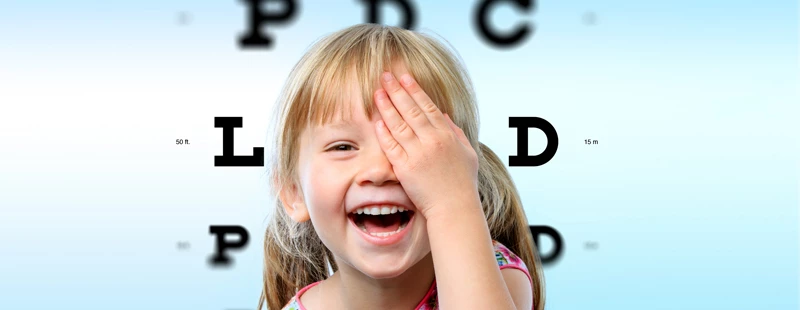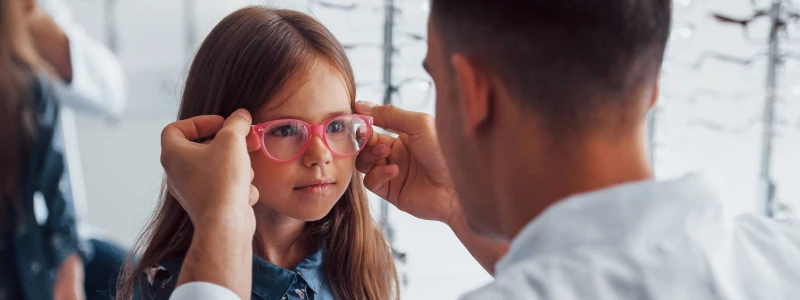
Nowadays, in the age of pandemics, we all use electronic devices much more frequently - data from the Digital2020 report [1] suggests that we spend with them an average of 6 hours and 43 minutes a day. In this time, we "flip" our eyes while being in the so-called visual near point (40-70 cm) and ultra near point (20-30 cm) ranges. Such intense strain on our eyes results in digital eye strain (DES). It is not a surprise that children and adolescents also struggle with DES, even more so when learning has largely moved to the virtual world in the pandemic era. As a result, the significant proportion of the younger generation went online much earlier than they should have (or earlier than their parents intended to allow them to). Students who previously used screens excessively now have an additional excuse: "I use the computer because I have a lesson". Unfortunately, the lockdown and restriction of other activities exacerbated their visual problems.
Electronic devices come in many shapes and forms: from televisions to desktop computer screens, laptops, tablets, smartphones and smart watches. The variety of these devices bring plenty of parameters for a user, some of them being:
eye to screen distance,
viewing angle,
a posture adopted when using a device,
picture quality settings: brightness level and contrast,
font size,
and consequently, also the variation in reported visual symptoms when visiting the optometrist's office. The closer the device is positioned to the eyes/the smaller the font the user is looking at for a long time, the more disturbance they may experience. The totality of these disorders falls under the umbrella of DIGITAL SENSITIVITY.
During distance learning, as suggested by the May 2021 report "Dzieci w pandemii" ("Children in the Pandemic”) [2]: students are using relatively new computers and laptops to participate in lessons - in 65% this is up to 5-year-old equipment. In addition to computers, smartphones (37%) and tablets (14%) are also used. It is worth remembering that any work with a device generates accommodation-vergence eye tension, i.e., such that engages, respectively, the muscles responsible for moving the eyes and the ciliary muscle responsible for adjusting the power of the system in the eyes to the distance at which we look, otherwise known as eye accommodation. This tension arises when working with smaller screens. This leads to accommodative spasms and, as a consequence, to asthenopic symptoms and increasingly poor long-distance vision (i.e., increasing myopia).

The most commonly reported post-digital symptoms (known as asthenopic symptoms) are headaches, eye fatigue and pain, conjunctival redness, tearing, concentration problems, blurred or double vision. The discomfort will fade away, and it does not cause permanent damage to the vision, but the persistence of this distress does not allow it to be underestimated. Asthenopia in children can have serious consequences, such as progressing myopia or learning difficulties. Children use device screens extensively, often for very long periods and at increasingly younger ages, which makes them extremely vulnerable. It is possible that the prevalence of asthenopia in children will increase in the near future, with additional consequences for learning and school performance.
Increasing myopia is another major visual problem occurring worldwide. It is associated with an increased risk of glaucoma or retinal detachment [3]. The World Health Organisation (WHO) estimates that by 2050 [4] half the population may be short-sighted. In recent years, insufficient time spent outdoors and excessive working at close distances have been identified as major risk factors for developing this impairment. Therefore, Children's eyesight is sensitive to environmental changes. This year's study in China [5] suggests that confinement at home during the COVID-19 pandemic was associated with a significant increase in the prevalence of myopia in school-aged children (6-8 years). Scientists have described this myopia as caused by the quarantine, which shows the stature of the problem.
Eyeballs can also often dry out when working at a computer. The frequency of the bl.ink reflex when focusing the eye at close distances decreases by up to 60 % [6] and therefore the tear film is not distributed properly. In addition, air conditioning, ventilation, draughts or low humidity lead to excessive evaporation of the already weakened tear structure. Dry eyes lead to further problems with visual acuity and a feeling of irritation. Frequent eye rubbing gives only a temporary feeling of improvement and can contribute to the development of corneal cone. At this point, it is also worth mentioning about the contact lenses so readily worn by teenagers. Please remember to use glasses when teaching remotely and for long periods in front of a screen in a closed room. Contact lenses intensify the sense dryness and can no longer be a convenient form of correction. However, if one needs to use them, it is vital to keep the hygiene in mind during the pandemic, to care with a solution designed for contact lenses, to support oneself with moisturising drops and a timely replacement regimen.
We, as parents, should consider how to help our children take care of healthy eyesight - and remember that prevention is better than cure. Below you will find preventive recommendations to help you avoid any discomfort.
Prevention of digital eye strain
Prevention of digital eye strain for both children and adults should include providing an ergonomic work environment. Pay attention to the distance between your eyes and the monitor. A standard distance between the monitor and your eyes should be around 60 - 70 cm. The optimum distance between the eye and the screen can be determined more precisely by adhering to the principles below:
the size of the characters on the screen is increased by approximately 150 times (e.g., characters are 4 mm, the distance from the screen should be 60 cm),
- or the diagonal screen size multiplied by 1.5.
Place the monitor sideways to the window - the light should not be reflected in it, as the reflections are additionally tiring to the eyes.
To maintain good visual hygiene, it is important to take regular short breaks from close work when the eyes can rest from the screen and the constant muscle tension. The American Optometric Association [7] recommends regular use of the simple 20/20/20 rule:
Every 20 minutes spent working with the screen, look for 20 seconds at a minimum distance of 20 feet (standard distance about 6 metres) |
It is also worth downloading one of the free applications available on the web, which will help you plan the time spent in front of the screen, remind you to take a break or suggest simple exercises for your eyes. In addition to breaks, you should work in close proximity only when really necessary. Looking at a computer screen, a smartphone or even a book for hours can cause discomfort and eye problems.
What is more, the basis for comfortable vision is a corrected visual impairment. That is why it is recommended that every pupil has an eye check-up once a year (unless otherwise advised by the specialist in charge). A properly conducted visit checks not only the parameters of visual acuity, but also anomalies of accommodation and eye movements. This will allow to adjust the optimal spectacle correction or improve the comfort of wearing contact lenses. Digital eye strain can cause excessive accommodation and therefore apparent myopia. This results in poorer vision in children, faster fatigue and lack of motivation to learn. For symptoms of accommodative strain, relaxation solutions involving the introduction of a relaxing zone in the spectacle correction are often indicated.
You should also pay attention to an adequate layer of tears covering the cornea. Learning to bl.ink properly can help - from time to time, look away from the screen and squeeze your eyelids tightly together to moisten the eyeball. In addition, a natural way to improve the quality of the tear film will be daily hygiene of the eyelid margins but use also artificial tear as a support in the case of prolonged work close to a screen. A perfect preparation is an isotonic solution of 6.5 - 7.5 pH and with ionic composition and viscosity corresponding to that of natural tears, containing no preservatives or preserved with compounds with no toxic effects [8].
Another recommendation for the prevention of vision is to stay outdoors, especially for children. This involves focusing the eye on distant points and therefore also relaxing the oculomotor and accommodative muscles used, for example, when playing games on a smartphone or during remote lessons. What is more, exposure to sunlight increases dopamine secretion, which is involved in visual signal modulation, but also recognised as an element engaged in the growth of the eyeball and therefore regulating the size of the visual impairment.
There are additional solutions available in optical stores containing blue light filters with properties that do not interfere with the regulation of melatonin and the diurnal rhythm, while not allowing too much blue light on the fundus of the eye. Following the above you can expect that some of the symptoms associated with digital eye strain will go away, and the likelihood of a retinal disease will be reduced.
ADDITIONAL PRECAUTION
Please make sure to remember that there are additional threats for a child who works with electronic equipment including strain on the spine, insomnia, reduced concentration, deterioration of relations with peers and parents (social isolation), and sometimes psychological disorders such as increasingly common media addiction.
The year started traditionally. We all hope that it will remain so for as long as possible. However, certain habits that our children have acquired during the last stage of their education may stay with us for longer. By following the above prevention principles, we can largely reduce the impact of screens and remote learning on young people's wellbeing. Developing the right habits will also pay off in the future. But if already notice signs of digital eye strain or our children's deteriorating vision, do not wait. Visit a vision care specialist - an ophthalmologist and an optometrist - who will diagnose possible vision defects and recommend appropriate solutions to improve not only the vision, but the whole functioning of a person.
Sources
[1] gazeta-optyka.pl/index.php/component/jdownloads/?task=download.send&id=15&catid=5&m=0&Itemid=101
[2]https://gfx.wiadomosci.radiozet.pl/var/radiozetwiadomosci/storage/original/application/5dd033c24b718f22eed2154feefbcd3c.pdf
[3] How does spending time outdoors protect against myopia? A review | British Journal of Ophthalmology (bmj.com)
[4] Progression of Myopia in School-Aged Children After COVID-19 Home Confinement | Ophthalmology | JAMA Ophthalmology | JAMA Network
[5] Wpływ pracy wzrokowej na film łzowy i stopień zmęczenia oczu. Alicja Pas-Wyroślak, Ewa Wągrowska-Koski
[6] https://www.aoa.org/AOA/Images/Patients/Eye%20Conditions/20-20-20-rule.pdf
[7]Suche oko u alergika – jak unikać, jak leczyć? Anna Groblewska, Ewa Bogacka https://www.proquest.com/openview/f0f4330dafec8bed130a9495fcaaeb42/1?pq-origsite=gscholar&cbl=1286337
By Weronika Kołeczek, M.Sc., September 2021.



